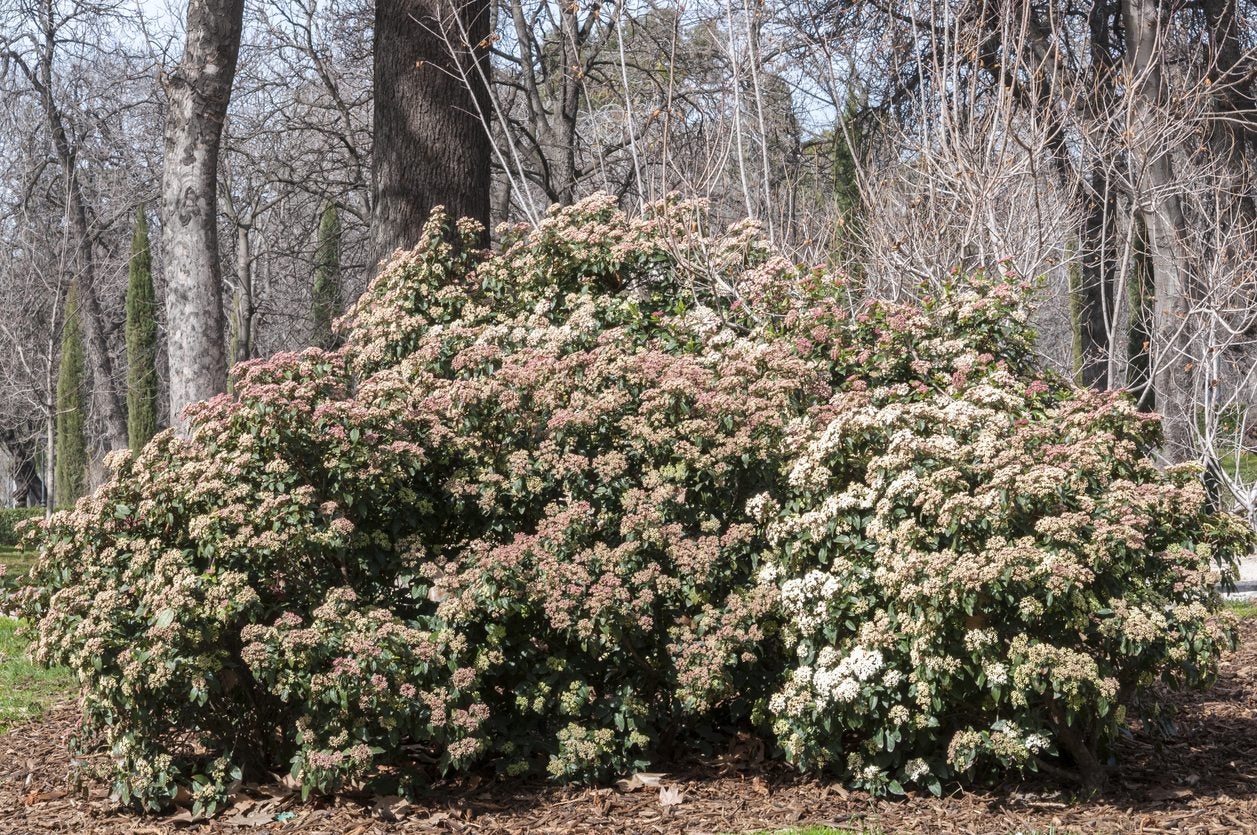Laurustinus Plant Information: Tips On Growing Laurustinus Shrubs


Laurustinus viburnum (Viburnum tinus) is a small evergreen hedge plant, native to the areas around the Mediterranean. It’s definitely a shrub to consider planting if you live in USDA zone 8 or warmer. It offers white flowers and annual berries. Read on for more laurustinus plant information, including basic instructions for growing laurustinus shrubs.
Laurustinus Plant Information
Laurustinus viburnum is one of the short viburnum species, and even unpruned specimens rarely exceed 12 feet (4 m.) in height. Some cultivars, like Laurustinus Spring Bouquet, are much shorter. The dwarfed height is one of the key features that makes growing laurustinus shrubs popular. A gardener seeking a short hedge won’t need to prune every other week to keep the plant the right size. Laurustinus plant information states that these evergreen shrubs produce flower buds as early as January. The buds are pink or red, but the flowers open white. If you are growing Laurustinus shrubs, you’ll see the flowers give way to blue-black drupes. These viburnum drupes look like berries.
Growing Laurustinus Shrubs
If you live in a warm region, it’s easy to grow Laurustinus viburnum shrubs. They thrive in full sun but accept less, thriving even in dappled shade. Plant these bushes where the soil drainage is good. Other than requiring good drainage, Laurustinus shrubs are very tolerant of various soil types, including sand and even clay. Laurustinus are known to be drought tolerant, but the shrubs bloom more profusely with a little extra irrigation. Don’t forget to provide water during the months that follow planting.
Laurustinus Spring Bouquet
The most popular cultivar of this viburnum is Laurustinus Spring Bouquet. This cultivar thrives in USDA plant hardiness zones 8 through 10 in shade or sun. As previously stated, it is a dwarf cultivar. Each plant grows to only 4 feet tall (1 m.) but can get as wide as it is tall. It too sets its buds in winter, producing flattened clusters of small, pink balls that look like berries. As April rolls around and the air warms, these pink balls open up into fragrant white flowers. They smell like honey. By June, the blossoms are done flowering. They drop petals and give way to metallic blue berries.
Gardening tips, videos, info and more delivered right to your inbox!
Sign up for the Gardening Know How newsletter today and receive a free copy of our e-book "How to Grow Delicious Tomatoes".

Teo Spengler is a master gardener and a docent at the San Francisco Botanical Garden, where she hosts public tours. She has studied horticulture and written about nature, trees, plants, and gardening for more than two decades. Her extended family includes some 30 houseplants and hundreds of outdoor plants, including 250 trees, which are her main passion. Spengler currently splits her life between San Francisco and the French Basque Country, though she was raised in Alaska, giving her experience of gardening in a range of climates.
-
 Moody Blooms For Spring: 8 Types Of Black Flowers To Add Drama To Spring Displays
Moody Blooms For Spring: 8 Types Of Black Flowers To Add Drama To Spring DisplaysFrom midnight burgundies to inky violets, several types of black flowers can enrich and embolden a spring display. Try these brooding bloomers for a moody garden
By Tonya Barnett
-
 Can Snake Plants Live Outside? Everything You Need To Know For Snake Plants Al Fresco
Can Snake Plants Live Outside? Everything You Need To Know For Snake Plants Al FrescoSnake plants can live outside given the right conditions, but be careful that they don't take over! Learn the best way to use snake plants in your landscape.
By Mary Ellen Ellis